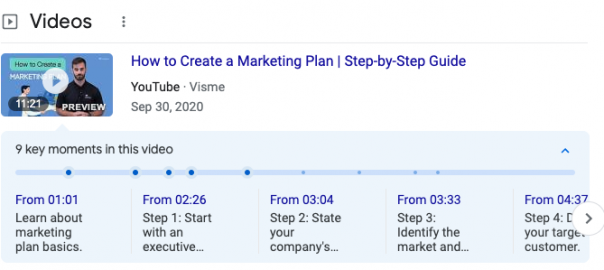So you want to use video marketing to improve your search presence? Let’s talk.
If you’re reading this, you probably already have a strong SEO strategy, backed by comprehensive buyer persona profiles, sound keyword research, and a robust content strategy. You also might already have a video marketing strategy. And now you want to learn how to leverage all that hard work to take your video SEO (VSEO) to the next level.
Take the recommendations outlined in this blog, and you’ll be well on your way to improving your search rankings with video.
Why You Should Care About Video SEO
First, it’s important to explain why you should root your video marketing strategy in SEO best practices.
“If you record it, they will come” could easily replace the old adage we all know. It’s no secret how widespread video has become, but its stock is far from the ceiling. Video marketing will continue to grow because businesses continue to see ROI, especially in the B2B space where there are still many who are slow to adopt.
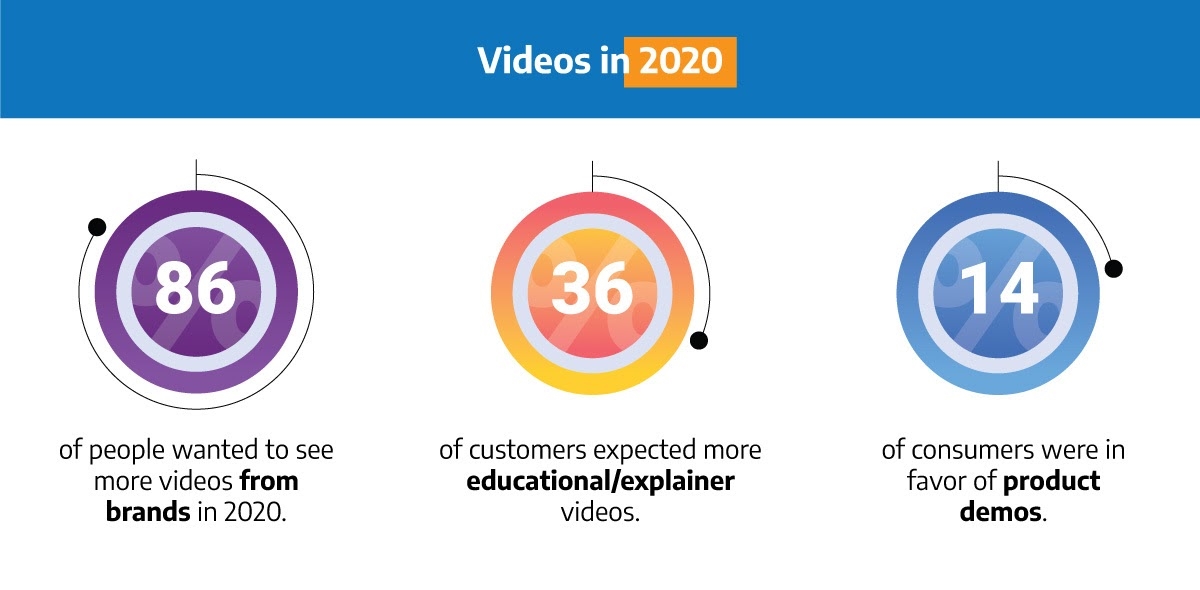
Source: brid.tv video marketing trends
Now, think about video marketing and SEO the same way you think about written content and SEO: They’re two sides of the same coin. Much like you optimize blogs for search, you should optimize video for search in a similar way. If you neglect VSEO, your videos will be viewed less and your ROI will suffer for it.
Taking Your Video SEO to the Next Level (with Real-World Examples)
Now, without further ado, let’s dive into some top techniques for building a solid video SEO strategy.
1. Determine what search intent you’re targeting before recording your video, and use those terms in your video.
As if you were writing a blog, you should create videos with your audience’s interests in mind. Some SEO experts prefer to plan their content around keywords, but I think it’s best to strategize around the search intent behind keywords. It sounds similar, because it is, but focusing on search intent gives you a higher vantage point when planning.
What this boils down to is how you approach content curation: Are you creating content that addresses your audience’s needs?
Search engines are sophisticated enough to understand the context of your video and use that in determining if it’s relevant to searchers’ intent.
This isn’t to say keywords shouldn’t be considered. It’s still important to have target keywords and track their rankings, but first you need to understand the intent of the search queries to determine which keywords are the right to use. Once you have the intent, conduct keyword research to identify related search terms and use those terms in your video.
A quick example: You own an ice cream shop, and one of your goals is to increase sales on your homemade ice cream product. You already create written content, and now want to take it a step further with video marketing.
So you conduct some customer research and realize that a lot of people are interested in making ice cream for their families. That last bit is their intent. Then, you pop over to Google’s Keyword Research tool to discover related search terms (read: keywords) such as:
- How to make ice cream
- Homemade ice cream
- Ice cream recipe
From this insight, you decide to create a tutorial video outlining how to make ice cream at home using your product, using your related search terms throughout your recording.
Actionable takeaway: Determine the intent of your video. Based on that intent, choose one primary keyword, a few long-tail keywords, and a handful of semantic (synonymous) keywords. Add those in naturally throughout the video transcript (don’t forget the title and meta description, which we cover next).
2. Choose a stellar thumbnail, title, and description for your videos.
How many books and movies have you skipped over because the cover didn’t capture you? Your video is no exception. The “book cover” for any video has three primary elements that appear in search results: the title, description, and thumbnail.

Take the extra time to be thoughtful about each element, putting yourself in your audience’s shoes. What do they care about? What drives them to take action?
Google and other search engines use search result interactions and page engagement as an indicator of content value: Are people clicking on your link? Are they staying on your page or leaving right away? How long are they staying on your page?
As a side note, you’ll probably already have your title by the time you’re optimizing your video for click-through rate (CTR), but that doesn’t mean you can’t optimize. Look at your existing videos—what’s performing better from a CTR perspective? Why? Make a hypothesis, test it, and implement it accordingly.
A quick example: Continuing our ice cream example from earlier …
- You title the video “How to Make Perfect Homemade Ice Cream with your Family.”
- You give it a pithy and actionable meta description, “Watch this 3-minute video to learn how to make delicious homemade ice cream the whole family will enjoy this summer.”
- You add a thumbnail picturing an irresistible-looking bowl of ice cream on a kitchen counter.
Actionable takeaway: Spend a few extra minutes creating a video title, meta description, and thumbnail worthy of capturing both the key points of the video and your audience’s attention.
3. Create a video sitemap on your website.
Much like a normal sitemap or blog sitemap, your videos should be housed in a sitemap of their own. This enables search engines like Google to quickly crawl and index all of the video content hosted on your website. Sitemaps also help search engines better understand the context of your webpage, post, or—in this case—video, through metadata.
There are two ways to create a video sitemap: manually or through a sitemap generator (or a video sitemap plugin if you use WordPress). Both options are a bit of a pain, but it’s a fairly “rinse and repeat” exercise once you get the hang of it. If you’re new to sitemaps or struggling to create one manually, I’d suggest using a sitemap generator.
This isn’t the easiest recommendation in this post to follow through on, but it’s worth it if you’re serious about your video SEO strategy.
A quick example: Here’s an example of what a video sitemap looks like. (Be warned: It’s code-based.)
Actionable takeaway: Create a video sitemap, and update it every time you create or modify a video. Be sure to instruct search engines to recrawl your site after any updates! For Google, recrawl requests can be done through your Google Search Console Account.
4. Add video transcripts on your pages.
Earlier, I mentioned that search engines are sophisticated enough to process and understand the dialogue in a video. With that said, it’s still a best practice to create and include a video transcript on the actual page your video is hosted. This leaves no room for error when search engines crawl your video.
Some websites elect to house the transcript inside a collapsible module, while others turn the video into a text-based guide. Both options are fine, depending on the context and goal of the video.
Now, before you start watching the video at 0.25x speed and transcribing it yourself, most video recording platforms (e.g., Zoom and GoToWebinar) automatically transcribe the video for you.
A quick example: If your video platform doesn’t automatically transcribe, you can leverage the power of YouTube’s free captioning feature through the following steps:
- Upload your video to YouTube.
- Open the YouTube video.
- Select “Open Transcript” under the ellipsis menu.
- Copy the transcript.
- Proofread the transcript, just to be safe!
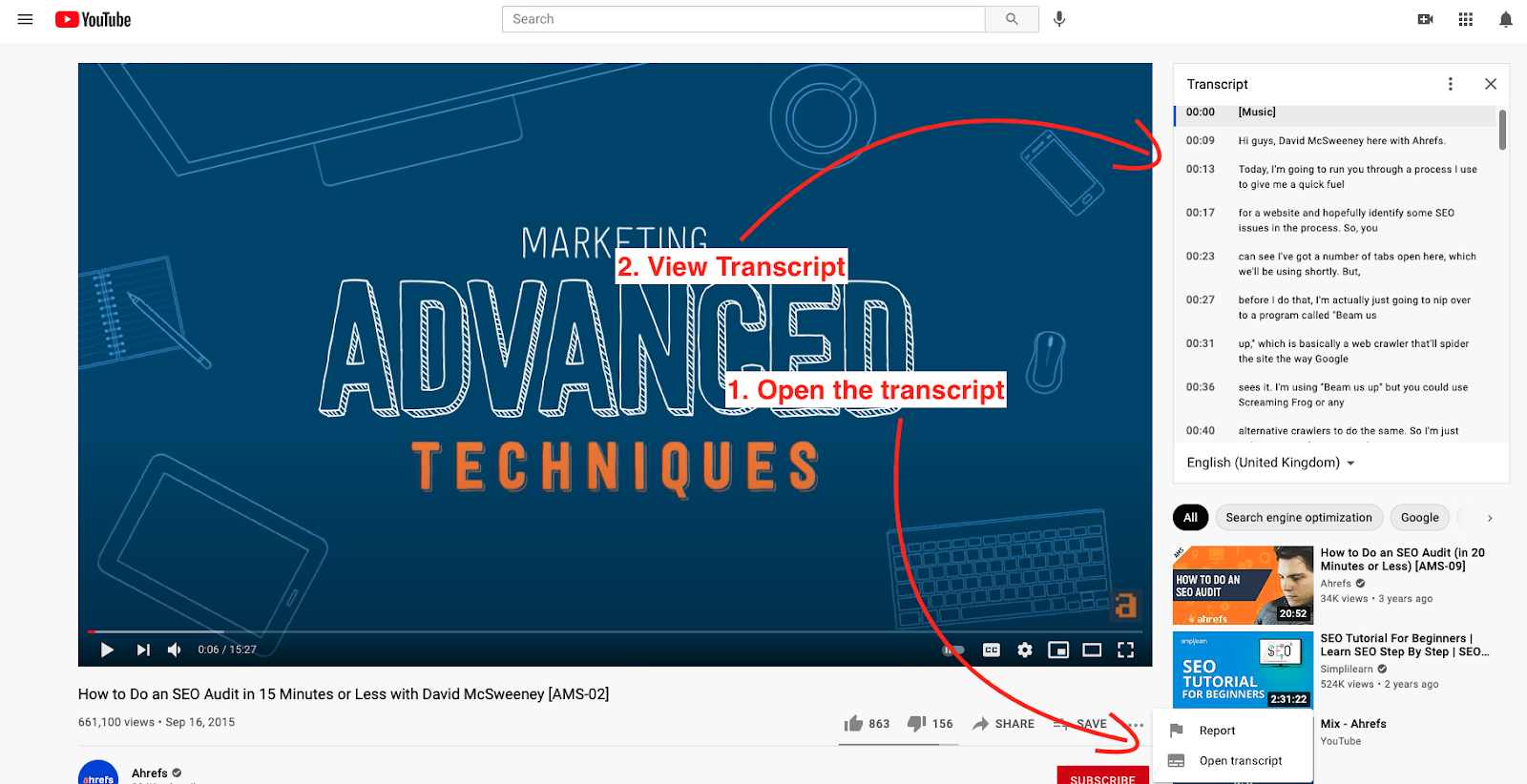
Now armed with your full transcript, add the copy to the page your video is hosted on.
Actionable takeaway: Generate a video transcript using either your native video platform or using YouTube’s free captioning feature. Add the full transcript on the same page as your video, using either a collapsible text module or by turning the transcript into a text-based walkthrough.
5. Add content to the page besides just the video transcript.
You might be noticing a theme throughout this post: Video SEO is very similar to traditional SEO.
This means that Google & Co. are always looking for the highest-quality content to display to their searchers. And one of the best ways to improve the quality is by improving the user experience through educational, informative, and unique content.
So be sure to add relevant content to your video page, which means going beyond the transcript (if you aren’t repurposing it as an on-page guide). Consider adding copy that outlines what the user can expect to learn from the video, key takeaways, and frequently asked questions.
Actionable takeaway: Don’t stop at including the transcript. You should add more relevant, quality content to increase the chances that both your page and your video rank well.
6. Use schema markup on all videos.
Schema markup (commonly called structured data) is code you add in the HTML of your pages to help search engines better understand your page and increase your chances to earn rich features on search engine results pages (SERPs).
Schema markup comes in all shapes and sizes, but for video, we’re going to want to focus on … drum roll … video schema markup.
Sidenote: the links shared here are to Google schema markup resources; however, Google and other search engines like Bing follow the structured data guidelines from schema.org (a collection of shared markup syntax created by webmasters, for webmasters). If you’re needing to add rich snippets, watch this explainer video by Google.
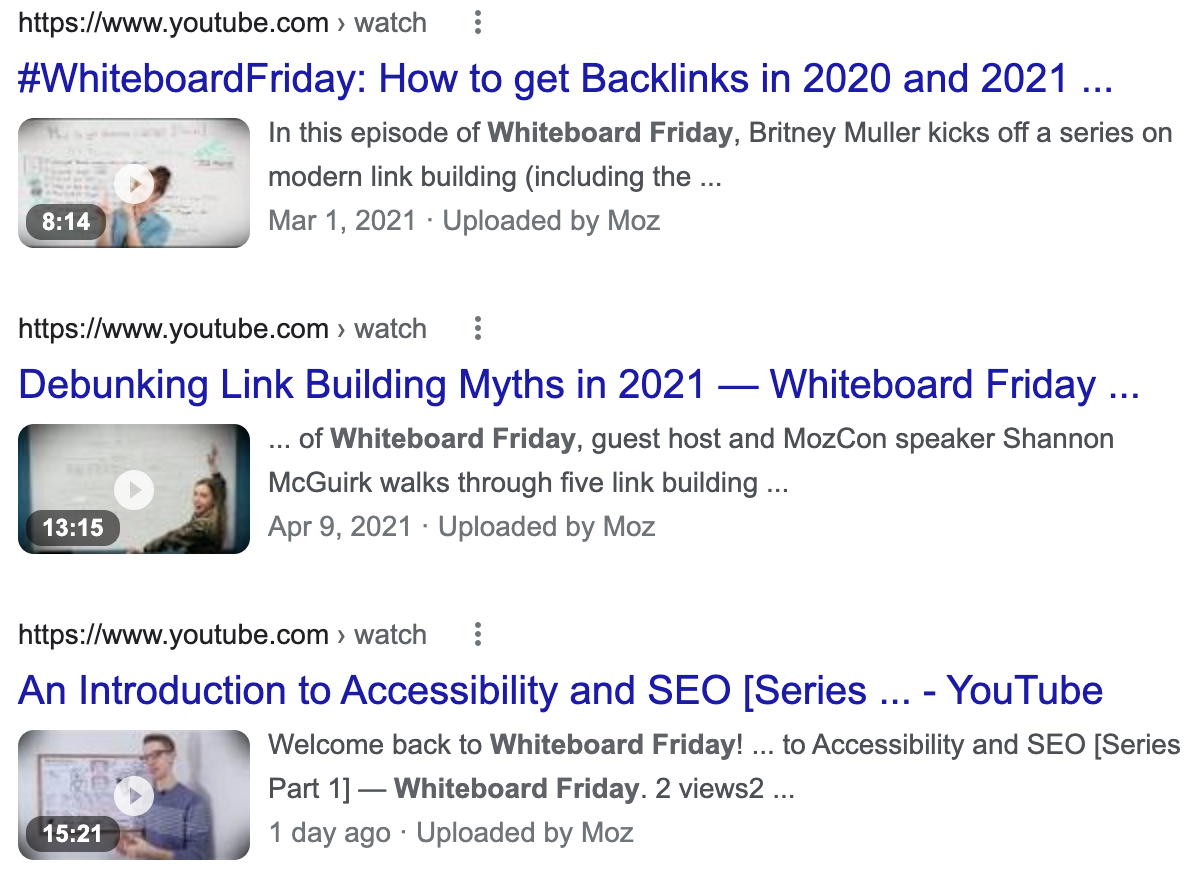
Google shows information about the video(s) directly on the results page—most notably the title, thumbnail, length, video description, and publication date. These extra details make your result stand out more, thereby increasing the likelihood that searchers will click that result.
To be eligible for Google’s rich video snippets, you need to host the videos on your own website. This ties in with the video sitemap recommendation above. Some websites opt to host their videos directly on YouTube, which is fine; however, the tradeoff is fewer visitors to your site. Consider your video marketing goals to determine the right approach.
Sidenote: If your website is hosted on WordPress, Yoast SEO plugin has a workaround for YouTube-hosted videos, but it’s still recommended to host the videos on your own website.
Actionable takeaway: Add video schema markup to videos hosted on your website in order to improve the likelihood your videos will appear as a video snippet on SERPs.
7. Add chapters to videos where relevant.
Certain video hosting platforms let you add chapters—or timestamps—to your videos. They act in the same way you would create chapters in a book, article, or really any content for that matter. Adding chapters to your videos not only helps from an SEO perspective (search engines can show the most relevant chapter to a searcher), but it’s also a great way to improve the user experience.
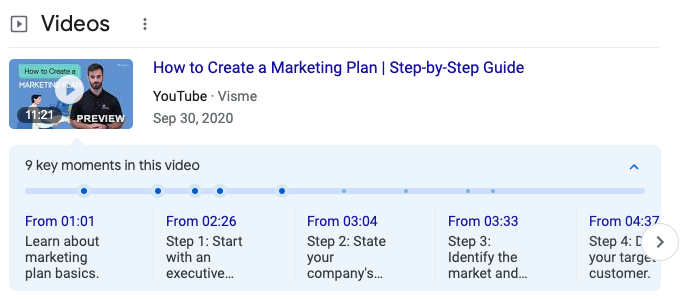
How you add chapters will depend on where you host your videos. At SmartBug, we use a popular platform called Vidyard, though most large video hosting platforms have chapter/timestamp functionality available.
Actionable takeaway: Break up your video by chapters, or timestamps, using your video transcript outline as a guide. Don’t make your chapters too granular or too high level; try and find the right mix that makes sense to your audience.
Keep Your Eye on the VSEO Prize
As mentioned above, it’s very important to keep your eye on the prize: Continuously ask yourself why you’re implementing a video (SEO) strategy. Always keeping in mind your north star—your business goals—will make sure your video efforts are rewarded in a measurable manner that yields quantifiable ROI.
When you write a blog, host a webinar, or launch a new product, do you create a webpage and then call it a day? Hopefully not. The same should go for your video SEO efforts. On top of the techniques outlined in this blog, be sure to incorporate other mediums to promote your videos, such as social, email, and sales activities.
Finally, don’t rest on your laurels. So your videos are drawing in organic traffic, leads, and customers? Fantastic. Dig into the “why” and “how,” then use what you learn to continuously optimize existing videos and apply that knowledge to future videos.
Digital & Social Articles on Business 2 Community
(48)
